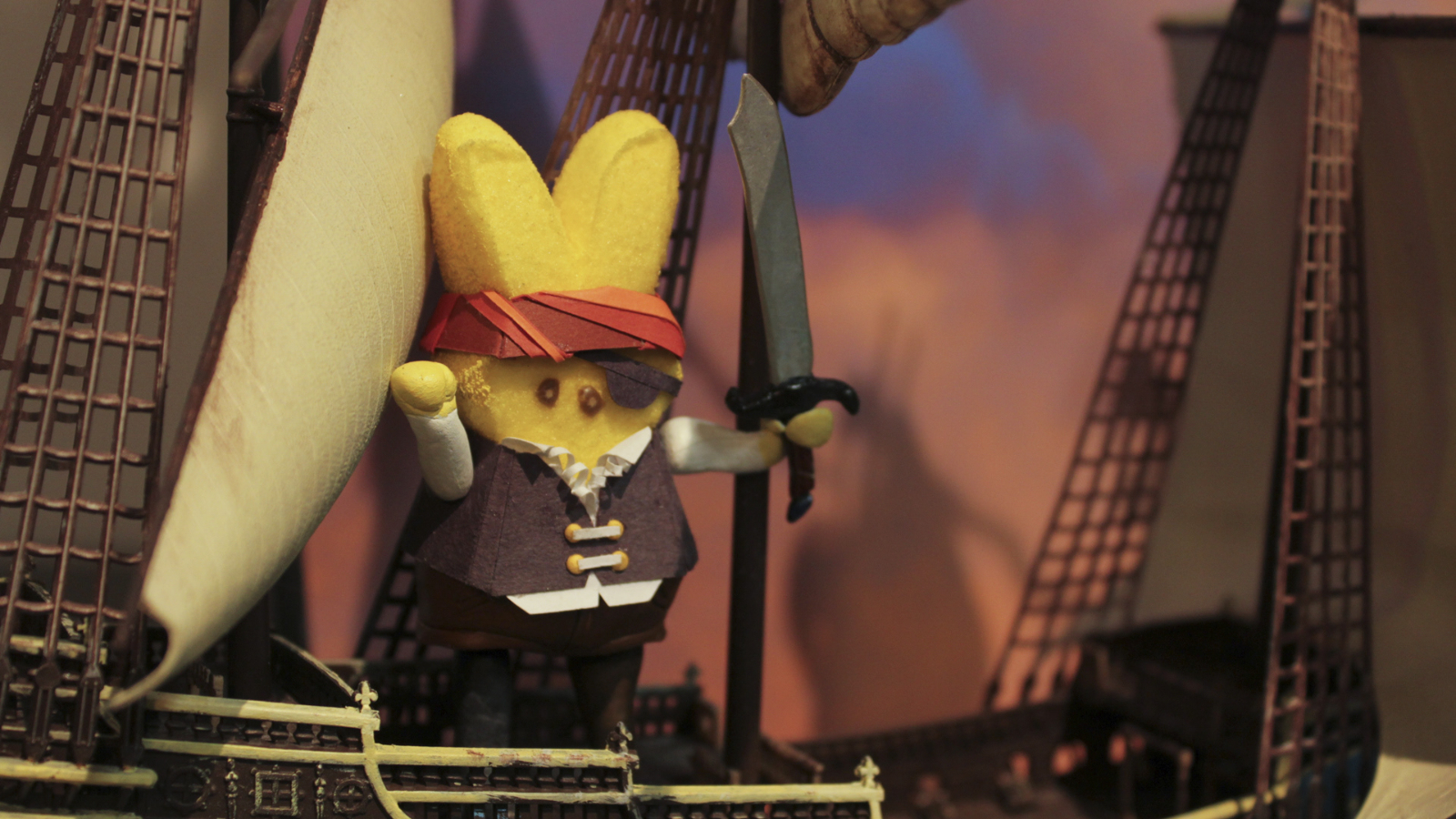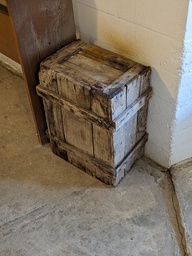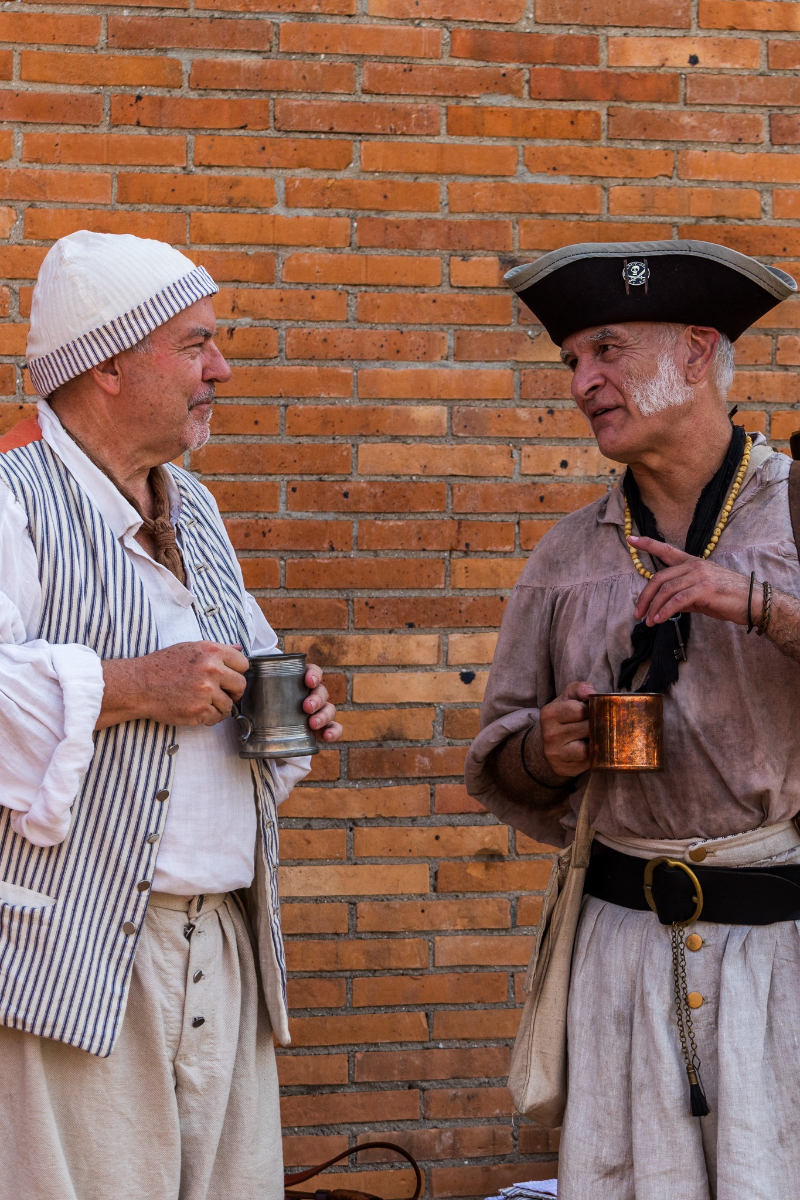-
Posts
3,750 -
Joined
-
Last visited
Content Type
Profiles
Forums
Events
Gallery
Everything posted by madPete
-
untilLantern Light Village December 6, 7, 13, 14, 20, 21, and 22 5 – 8 p.m. Take a journey through time this holiday season at Mystic Seaport Museum! What connects the festive seasons of bygone days to the present? The spirit of love that enchants us all. Love for each other, for seasonal traditions of every kind, for twinkling lights and carolers. This holiday season, join us at the Museum’s Lantern Light Village and feel the love! Immerse yourself in evocative lantern light and the sound of music-fueled twinkling displays as you explore the Museum after dark. Take in our riverside campus brimming with the tastes and sounds of the season, from holiday cookies and carolers, to old-time dances, a horse-drawn carriage ride, crackling fires, and a visit with Saint Nick. Reminiscent scenes will transport you back in time while village townspeople from 1876 share their love stories, memories, and traditions as they prepare for a festive and joyful holiday. Enjoy games, family crafts, music below deck on the Charles W. Morgan, and so much more. This year discover why the new Lantern Light Village experience at Mystic Seaport Museum is a fun and magic-filled tradition for so many. This event has staggered entry times: 5:00, 5:30, 6:00, 6:30, 7:00, and 7:30 p.m. Members: Adult $24, Youth (ages 4–12) $20, children 3 and under FREE Non-members: Adult $30, Youth (ages 4–12) $25, children 3 and under FREE https://mysticseaport.org/lantern-light-village-2024/
-
untilLantern Light Village December 6, 7, 13, 14, 20, 21, and 22 5 – 8 p.m. Take a journey through time this holiday season at Mystic Seaport Museum! What connects the festive seasons of bygone days to the present? The spirit of love that enchants us all. Love for each other, for seasonal traditions of every kind, for twinkling lights and carolers. This holiday season, join us at the Museum’s Lantern Light Village and feel the love! Immerse yourself in evocative lantern light and the sound of music-fueled twinkling displays as you explore the Museum after dark. Take in our riverside campus brimming with the tastes and sounds of the season, from holiday cookies and carolers, to old-time dances, a horse-drawn carriage ride, crackling fires, and a visit with Saint Nick. Reminiscent scenes will transport you back in time while village townspeople from 1876 share their love stories, memories, and traditions as they prepare for a festive and joyful holiday. Enjoy games, family crafts, music below deck on the Charles W. Morgan, and so much more. This year discover why the new Lantern Light Village experience at Mystic Seaport Museum is a fun and magic-filled tradition for so many. This event has staggered entry times: 5:00, 5:30, 6:00, 6:30, 7:00, and 7:30 p.m. Members: Adult $24, Youth (ages 4–12) $20, children 3 and under FREE Non-members: Adult $30, Youth (ages 4–12) $25, children 3 and under FREE https://mysticseaport.org/lantern-light-village-2024/
-
untilLantern Light Village December 6, 7, 13, 14, 20, 21, and 22 5 – 8 p.m. Take a journey through time this holiday season at Mystic Seaport Museum! What connects the festive seasons of bygone days to the present? The spirit of love that enchants us all. Love for each other, for seasonal traditions of every kind, for twinkling lights and carolers. This holiday season, join us at the Museum’s Lantern Light Village and feel the love! Immerse yourself in evocative lantern light and the sound of music-fueled twinkling displays as you explore the Museum after dark. Take in our riverside campus brimming with the tastes and sounds of the season, from holiday cookies and carolers, to old-time dances, a horse-drawn carriage ride, crackling fires, and a visit with Saint Nick. Reminiscent scenes will transport you back in time while village townspeople from 1876 share their love stories, memories, and traditions as they prepare for a festive and joyful holiday. Enjoy games, family crafts, music below deck on the Charles W. Morgan, and so much more. This year discover why the new Lantern Light Village experience at Mystic Seaport Museum is a fun and magic-filled tradition for so many. This event has staggered entry times: 5:00, 5:30, 6:00, 6:30, 7:00, and 7:30 p.m. Members: Adult $24, Youth (ages 4–12) $20, children 3 and under FREE Non-members: Adult $30, Youth (ages 4–12) $25, children 3 and under FREE https://mysticseaport.org/lantern-light-village-2024/
-
untilSaturday, Dec. 16, 5 pm to 10 pm 1st Annual Renaissance Fair Pub Crawl Downtown Melbourne 2023 Six (6) drinks $20 in advance on-line only or $30 day of. An exciting NEW Pub Crawl in cooperation with the Brevard Renaissance Fair https://brevardrenaissancefair.com Themes are Pirates, Fantasy, Viking, Heroes and Celtic! 50/50 Drawing to benefit The Agency for Life Transformations www.altsuccess.org Starts at 5pm to 6pm Drews Brews & Grille 2101 Henley Court, Melbourne, FL 32901 followed by: 6:00 to 7:00 – Lumber Jack's 7:00 to 8:00 – Debauchery 8:00 to 9:00 – Meg O'Malley's 9:00 to 10:00 - Mugsy's on Main Extra Credit Stop Included Ticket entitles the bearer to a choice of one beverage between two or more beverage choices per stop: a draft beer, a house wine, a well drink, a punch or a sangria depending on what is offered. Choices vary at each stop. Tickets are no longer valid after the end of the event. You MUST be at least 21 years old to buy tickets. Cash Only! No Refunds! There will be a core group following the posted order, but you do not have to be part of it. Stops can be made in any order. DO NOT LOSE TICKET AS IT CANNOT BE REPLACED! Free ride home if you become incapacitated – Conditions apply and are detailed on the web site. KEEP THIS TICKET! Attend 5 Pub Crawls and the 6th one is FREE! Beverages are NOT allowed on the street. You MUST consume any and all alcohol before leaving any of the stops! We employ professional photographers at out events. Purchasing a ticket gives us permission to use your image. MadHatterPromotions.com is a for profit entertainment business. However, we always include a charity at our events. We have raised thousands of dollars for various charities over the years. We sincerely appreciate your support. Thank you. * Tickets purchased via PayPal are acknowledged by email and are picked up at the event. Advance ticket purchase option (PayPal) at MadHatterPromotions.com will be removed at least one day before the event. https://www.madhatterpromotions.com/2023-renaissance-fair-pub-crawl-downtown-melbourne.php
-

The Traveling Yard 2023 - Information and Sign Ups
madPete replied to Duchess's topic in Arts of Pyracy
I'm sure at least one of them ends up in a frame on the wall. -

The Traveling Yard 2023 - Information and Sign Ups
madPete replied to Duchess's topic in Arts of Pyracy
Don't make em too rustic. Someone mght use them to blow their nose LOL -

The Traveling Yard 2023 - Information and Sign Ups
madPete replied to Duchess's topic in Arts of Pyracy
There's so much wrangling just to get to the fun parts! -
untilOlde Tyme Productions Inc. has operated the Escondido Renaissance Faire for more than 20 years. Two weekends! Apr 26-27 abd May 3-4 Event Activities: Jousting Tournament Dual Stage with Live Entertainment Clothing, Weapon and Trinket Shoppes Food/Drink: Turkey legs and delicious nourishments Beer, ale, mead and of course, rum Costume attire is encouraged, not required https://www.oldetymeproductions.com/escondidorenaissancefaire
-

St Augustine - Ship found in Florida road construction from 1800s
madPete replied to madPete's topic in Shipwright
wow - there was a lot of embedded links when copying that... I removed the ones that weren't pertinent. -
https://www.foxnews.com/us/florida-road-crew-unearths-unusual-find-1800s-highway Florida road crew unearths unusual find from 1800s in highway The shipwreck was so well preserved that archaeologists reportedly found leather shoes, coins and coconut halves likely used as cups By Chris Eberhart Fox News Published October 20, 2023 1:14pm EDT Marine archeologists have discovered the shipwreck of the S.S. Pacific, which sank in 1875. It is believed to be incredibly well preserved and could contain priceless artifacts. (Northwest Shipwreck Alliance) Road crews found an intact, centuries-old shipwreck embedded in a Florida highway during routine construction work earlier this month. The 20-foot-long artifact, believed to date back to the 1800s, was buried under about eight to 10 feet of sediment near the Bridge of Lions in St. Augustine and was so well persevered that crews found a left leather boot. "We believe the vessel may have sank unexpectedly and, over time, was silted in," Florida Department of Transportation (FDOT) District 2 Secretary Greg Evans said. "That is why it was preserved so well. It was encapsulated in soil and mud, so there was no air contact for it to decay. It’s truly an incredible find." A shipwreck was found during road work in Florida. (SEARCH, Inc/Florida Department of Transportation) Construction was temporarily paused as the Florida Department of Transportation works with SEARCH, a global leader in archeology that has completed over 4,500 commercial and government projects in 48 U.S. states and 36 other countries. The ship's origin is still a mystery, and it will likely take time to uncover the vessel's tales. SEARCH's Dr. James Delgado, who led the excavation and recovery, said in a statement that they believe the vessel "was a small single-masted, shallow-draft sailing craft of the 19th century." A remarkably intact ship found under a Florida highway during construction is estimated to date back to the 1800s. (SEARCH, Inc/Florida Department of Transportation) "It was likely used to extract fish and shellfish from coastal waterways and directly offshore," Delgado said. "With a dedicated team, including support from the local community and the on-site construction team, we were able to extract the vessel in order to allow the important work on the community’s infrastructure to continue." The vessel was found eight to 10 feet under the Florida highway. (SEARCH, Inc/Florida Department of Transportation) In an interview with Newsweek, Ian Pawn, an archeologist at the Florida Department of Transportation, detailed some of the artifacts that were amazingly still intact. On top of the ship, they found leather shoes, coins (one dates to 1869), coconut halves "that were likely used as cups" and a portion of an oil-fired lantern, Pawn said. A drone shot of the site where archeologists are working in Florida to preserve the shipwreck. (SEARCH, Inc/Florida Department of Transportation) SEARCH archeologists have to race against the clock to preserve the vessel before the elements dry the wood, and the ship and its hidden treasures decay. "The boat was disassembled, plank by plank, and removed, with great care to keep each portion wet," Pawn said, according to Newsweek. Several artifacts, including this leather boot, were found atop the hidden vessel. (SEARCH, Inc/Florida Department of Transportation) "The pieces will be observed in wet storage to stabilize as we determine future preservation effort. We will be working closely with archeologists and the City of St. Augustine to find a permanent home for this unique find." FDOT's Evans thanked SEARCH's "careful efforts to preserve this vessel." Artifacts, like this piece of a lantern, were found atop the vessel in a Florida highway. (SEARCH, Inc/Florida Department of Transportation) Crews have to keep the wood wet, or the elements will dry it and speed up the decaying process. (SEARCH, Inc/Florida Department of Transportation) "With every project we undertake, the Florida Department of Transportation is sensitive to the unique needs of the communities we serve, including the potential presence of historical sites and artifacts within construction sites," Evans said in a statement. "We look forward to learning more about its significance to the region."
-
mmmmm.... Tastes like chicken!
-
And didnt have Miranda's Navigation skills!
-
He got lost...
-
Patience is a virtue. But we hear you...
-
Done!
-

MIlitary Through the Ages, Jamestown - WIlliamsburg, VA
madPete posted an event in Community Calendar
untilMarch 15-16, 2025 • Jamestown Settlement Make ready for centuries of military history – all in one weekend – during Jamestown Settlement’s time-honored Military Through the Ages event. Military Through the Ages features hundreds of re-enactors depicting armed forces from 500 B.C.E. all the way to modern-day soldiers with the Virginia Army National Guard. As one of the most unique chronological displays of military history, Military Through the Ages invites visitors to explore military encampments and interact with re-enactors to learn how uniforms, weapons and tactics evolved through the centuries. ABOUT JAMESTOWN SETTLEMENT Open 9 a.m. to 5 p.m. daily (except Thanksgiving, Christmas and New Year’s days), Jamestown Settlement is located on State Route 31 just southwest of Williamsburg. Café and museum shop open during museum hours. https://www.jyfmuseums.org/events/programs-activities/military-through-the-ages -
untilThe past is yours to savor at the Feast of the Hunters’ Moon. At this historic reenactment you can recapture 18th century life at Fort Ouiatenon—the first fortified European outpost in what is now Indiana. The Feast of the Hunters’ Moon is a re-creation of the annual fall gathering of the French and Native Americans which took place Fort Ouiatenon, a fur-trading outpost in the mid – 1700s. It is held annually in early autumn on the banks of the Wabash River, four miles southwest of West Lafayette, Indiana. Thousands of participants re-enact this event creating a feast for your senses. Smell the wood smoke, hear the report of the rifles, savor authentic food and more. Continuous, free programming is held on five stages. French and Native American music and dance, fife and drum corps performances, military drills and demonstrations, fashion shows, games and contests can be enjoyed at the 50th celebration of this event. Special hands-on activities include the children’s trade blanket, costume try-on, candle-dipping, story telling, bead bracelet making, cross-cut sawing, and tomahawk throwing. We hope to see you there! Sat 9am-5pm Sun 9am-4pm http://feastofthehuntersmoon.org/
-
The above link is dead. Here is a new one with rowing commands: https://www.thebigrow.com/?page_id=404 and just in case this link goes bad, here is the text: Rowing Commands – Full List by Rebecca Manthey and David Manthey – originally written May 2004, last update 8 December 2011. Copyright 2004, 2011 by Rebecca Manthey and David Manthey. Introduction This is a list of commands used in rowing and sailing a small boat as was used in the late 18th century. Alternate Forms of this List This list of commands is also available as a PDF file. For crew just starting out, you may wish to begin with the Short List of commands. Sources Various references have been used to verify that these are period-correct commands. The following sources have been used: A Vocabulary of Sea Phrases and terms of art used in seamanship and naval architecture, by a Captain of the British Navy. London: printed for J. Debrett, 1799. This translates English and French naval terms between the two languages, and often gives commands explicitly. This is the foremost reference used. Unless otherwise marked, commands are present in this volume. The Mariner’s Dictionary, or American Seaman’s Vocabulary. Washington D.C.: William Duane, 1805. Commands marked with 1 are based on this work. This book doesn’t give commands explicitly as such, but rather has dictionary entries. Commands drawn from it may not be exactly worded the same as was used originally. Noel, John Vavasour, Naval Terms Dictionary. Annapolis: Naval Institute Press, 1978, originally published 1952. Not thorough, but a good work. Commands taken from here are marked with 2. Cornell, Felix M., American Merchant Seaman’s Manual. New York: Cornell Book Shop, 1938. Not as extensive as the preceding work. Commands taken from here are marked with 3. Lastly, there are some defects in the complete command list that are made up with our best guess. These have been marked 9. General Commands Preparatory command is “Stand by to…” Modifiers: Easy: very slowly Handsomely: Do it slowly. Cheerly: mid-speed Smartly2: Do it with vigor. Man the Boat! The boat crew is called to and boards the boat. If one of the crew is appointed to handle mooring lines, that man stands by the mooring lines. Attention! or Eyes in the Boat!9 Stop skylarking and pay attention to the captain. Thus! or Very Well Thus! or Steady! Keep doing the current activity just the way it is being done. Belay That Command! Cancel the last order. This can also be used more specifically, such as Belay Casting Off! Knock Off There! Stop a task. Not urgent. That’s Well!2 Stop a task. Not urgent. Avast! Urgent stop. Bear a Hand! or Light (a task)! Help out. Ready! A response from a crew that is ready to carry out a task. Most often used by a gun crew after preparing the gun for action. Disperse! The crew is dismissed from duty. A note on Larboard and Starboard: These phrases refer to the particular side of the boat, not of a person. The starboard side is the right side of the boat when in the boat and facing the bow. The larboard side is the left side of the boat when in the boat and facing the bow. The term port was used in the 18th century, but only when referring to the rudder of a ship to avoid the confusion of the similar sounds of larboard and starboard. It would not be used in a bateau, but, just the same, its meaning would be understood. The Rowing Commands are as follows: [We’ve elected to not teach feathering to new people; it confuses them so. Therefore, instead of the blade being parallel to the water surface, we end perpendicular to the water surface. However, feathering is easily done by experienced rowers, and should always be done at Bank Oars.] Any command may be prefixed or suffixed by All, Together, Starboard, Larboard, Stroke (only the stroke oar, sometimes called Strokesman), Bows. Stroke and Bows can be combined with Starboard or Larboard to get a specific person. Together and All are interchangeable. Get Your Oars to Pass! Starting with the oars stowed in the boat, the oars are passed outboard and to their appropriate rower. The blade is laid forward on the gunwale or extending over it, with the handle of the oar near the rower, and the forward oars inboard of the after ones. The handle of the oar is closer to the stern than the blade of the oar. [In modern vernacular this command is Stand By Your Oars!] Note: as this is the opposite of Boat Oars, we have been using it as a command to pass the oars to the appropriate rower and come to Toss Oars. Toss Your Oars Up! or Toss Oars! Oars are swiftly brought to the vertical, blades trimmed fore and aft. The handle of each oar is to be between the feet of the oarsman on the floorboard, the outboard hand holding the loom at chin level, the inboard hand holding at thigh level. Let Fall! From Toss Oars, the oars are quickly, but in a controlled motion, brought down from the vertical to the horizontal, loom resting in the thole pins. This ends in the same position as Oars. Give Way Together! or Pull! Oarsman row together in a forward direction, keeping time by watching the strokesman. Oar blades should be vertical when pulling, horizontal when recovering from the stroke. Can also be given to only the Larboard or Starboard side Oars!2 Once finished with the current stroke, oars are brought to the horizontal, blades parallel to the water’s surface. Pick Up The Stroke!2 The oarsmen not already giving way join in on the start of the next stroke. This is typically given after one side has been rowing and the other side has been at Oars, Hold Water, or Back Astern. Hold Water! Outboard hand grabs gunwale aft of oarlock, inboard arm is placed over oar so that the handle is in the armpit. The blade is vertical and placed in the water by the raising and bracing of the body of the oarsman. Care should be taken when this command is given at speed, as the force transmitted to the oarsman is great. At speed, the oar is placed in the water with the blade parallel to the direction of motion, so that most of the water slips by the oar. The oars are gradually turned until they are flat with the water. Note that the helmsman should give a warning to novices when the command is issued at speed. Back Astern! (sometimes Stern All!) Oarsman row together in an astern-motion, with the stroke oarsman setting the pace. Should not be given at speed, use Hold Water! to take way off before backing. Can also be given to only the Larboard or Starboard side. [Note, Back Water!2 appears to be a 20th century command.] Bank Oars!9 Oars are slid in until the handle rests under the gunwale on the far side of the boat. [I see no reference to this command anywhere, but feel it must exist. I think that this is actually Unship Oars!, but that seems terribly confusing.] Out Oars!3 From Get Your Oars to Pass! or from Bank Oars!, outboard arm cradles oar at elbow, inboard hand on handle, oar is lifted to a 45 degree angle and swung into the thole pins. Oars are lowered to the horizontal. [The period correct version of this command is Ship Oars!, but that seems confusing.] Trail Oars!2 This is used for holding water when at significant speed. The oar is placed in the water with the blade flat to water, and with the oar slanted so that the blade is slanted well behind the rower (toward the bow of the boat). Trail Oars can also be used when passing through a narrow space when oars cannot be tossed. In Bows!2 (sometimes just Bows!) The one or two oarsmen closest to the bow finish the stroke, lift oars simultaneously to an angle of 45 degrees, and boat the oars together. They move closer to the bow, if necessary, and stand ready to throw lines, use boathooks, etc. Boat Your Oars! Can be given from Oars or Toss Oars. The oars are passed overhead into the center one at a time and stacked along the centerline in a wide boat or along the sides in a narrow boat. The steering oar is placed on top. Oars are always stowed with the blade toward the bow and above the thwarts. Rowed Of All! or Way Enough!2 Inboard hand on the handle, outboard arm lifting oar in the crook of the elbow, the oar is tossed to 45 degrees, and swung in to lay on the gunwale, blade flat, after oars outboard of forward ones. This is a single command that takes the place of Oars, Toss Oars and Boat Oars. [I prefer Way Enough!, though Rowed of All! appears to be the correct phrase for the 18th century.] Point the Oars! To shove off a boat that has grounded, the bow oarsmen point the blades of the oars forward and downward onto the beach, ready to Shove Off! at the command. Row Dry! Stop splashing. The Mooring and General Boat Commands are as follows: These are in addition to general line-handling commands. General line-handling commands are listed afterwards. Note that no anchoring commands have been listed. Hoay! or Ahoay! Call to get the attention of someone. Holloa! Response to Hoay! Hoay, the Boat Ahoay! Call from a ship to the boat. The response varies depending on who is on board the boat. If a captain of a ship is on board, the response is the name of his ship. Other responses are ‘Aye, Aye’ if it is an officer, ‘No, No’ if it is a warrant officer, ‘Okay’ if it is just men, ‘Passing’ if the boat isn’t coming alongside. There are also special responses if one carries an Admiral, a monarch, the President, or a member of the Cabinet. Hoay, the Ship Ahoay! Call to a ship (not a boat). The response should be Holloa! or the name of the vessel. Cast Off! Only used with the boat’s own mooring lines. The line is unwrapped from the cleat or bitt on the dock or other vessel, so that it can run free. Take In (a line)! Pull the specified line into the boat, typically the bow painter or a mooring line, coiling it and stowing it in its place. Cast Away (a line)! Only used on lines from another vessel or dock that are used for securing the boat. For instance, in a lock, the lines running down from the lock walls are cast away when the boat is ready to depart. Shove Off! Push off from the dock, wall, shore, or other boat. This can be done with oars, a boat hook, or by hand. In Fenders!2 Take the fenders into the boat. If there is no urgency, the fenders should be held so that much of the water drains from them before placing them into the boat. Out Fenders!2 Deploy the fenders over the side to protect the boat from chaffing. Fend Off! or Fend the Boat! Using the oars or boathooks, keep the boat from brushing against another boat, dock, wall, or rock. Bale! also spelled Bail! Get the water out of the boat. This can be done using sponges, buckets, or pumps. Trim The Boat! Move toward the center or edge of the boat so that the boat is level. Occasionally when travelling into or with the wind, the boat will be trimmed forward, aft, to larboard, or to starboard to give it better stability. The Line Handling Commands are as follows: Let Go (a line)! or Cast Loose (a line)! or Loose (a line)! Undo the rope from the cleat, keeping a firm grip on it and with the line running under the cleat so as to be able to apply force to it. Make (a line)! or Belay (a line)! Secure the line on the cleat or belaying pin. Slacken (a line)! or Ease Off! Give slack as it is required, keeping the line taut but not strained. Pay out (a line)! Feed the line past the cleat or belaying pin. This is used when Slacken doesn’t let the line run freely enough to allow the line to be hauled or when used for an anchoring line. Haul (a line)! Pull in the line. Heave! A general pulling command. This is often used when multiple men are working at a single task to synchronize their efforts. Hold (a line)!, Check (a line)!, Snub (a line)! These commands are similar, though vary in degree. In all cases, the line is passed under the arm of the cleat or around the belaying pin. Tension is kept on the line to prevent it from moving. When snubbed, the line is held so that it won’t move under any circumstances unless it feels that the line is about to part. When held, the line is allowed to move if a reasonable force is applied to it. Checking is somewhere between holding and snubbing. Hang On (a line)! Hold the line. In this case, the line is NOT passed around a cleat, belaying pin, or bitt. Set Taut (a line)!2 Remove the slack from the line. Clear (a line)! Untangle the line. Bend (a line to an object)! or Fasten (a line to an object)! or Hitch (a line to an object)! Tie the line to the object using an appropriate knot. The converse is Unbend (a line)! and Unhitch (a line)! Reeve (a line through an object)! Pass the line through the object. Most often used when rigging blocks or deadeyes. The converse is Unreeve (a line)! Coil (a line)!, Fake (a line)!, Flemish (a line)! All of these commands are used to neatly stow a line. Unless explicitly commanded to do otherwise, lines should always be coiled inside the boat and flemished on docks and piers. This should be done without waiting for a command to coil or flemish the line – the action should be part of making the line. Coiling is typically done for stowing the line. It involves coiling the line neatly and in such a manner that it can run free. Inside of the boat, the coil should be hung on a cleat or on the stringer. Faking a line is arranging it in coils so that it can run free when it is slackened. Typically, this is done before letting out a large amount of line, such as letting out the halyard. Flemishing is coiling the rope in a flat coil, typically on a dock. The Sailing Commands are as follows: In addition to larboard and starboard, when under sail, commands can be given for Leeward and Windward. The windward side of the vessel is the side that the wind is coming from. Leeward and windward are not used with oar commands, only with sailing commands. [As our crew does not have much sailing experience, these terms will be used sparingly.] Step the Mast!1 On a small boat, the mast is often left down until needed. Stepping requires two men. The mast is laid in the boat so that the halyard and pennant lines may be rove through the appropriate dead-eyes. After these lines are rove, the first man lifts the mast and elevates it above the mast thwart. The second man positions the yard so that is if forward of the mast and the truss or parrel is around the foot of the mast. The first man then lowers the mast through the hole in the mast thwart, with the second man guiding the mast. The two men seat the mast firmly but gently into the keelson plate. The pennant line and halyard are then tautened and made. It is important to make sure that the halyard and the pennant line are rigged prior to stepping the mast. Hoist Sail! or Make Sail! or Set Sail! This a single command for the following: “Let Go the Halyard, Sheets, and Braces. Slacken Braces and Sheets. Haul Halyard. Sheet Home the Sail. Make All.” If the sail is furled, the sail is first unfurled by releasing the furling gaskets. The brace and sheet lines are then rigged to their appropriate cleats. Note that if the sail was properly furled, the sail can be unfurled by spilling all of the furling gaskets, then unwinding them from about the sail. The furling gaskets should not be removed from the yard. Sheet Home! Haul both sheet lines until the sail is taut and the flat. Used when first setting sail and sometimes before lowering sail. This is the same as “Let Go the Sheets! Haul the Sheets! Make the Sheets!” The correct amount of tension will depend on the force of the wind. In general, the sheets should be taut enough to keep the sail from fluttering, but not so taught as to pull it too far aback. Strike Sail! or Douse Sail! This is a single command for the following: “Let Go the Halyard, Sheets, and Braces! Slack Halyard! Haul Braces and Sheets! Make All!” Douse can also be spelled dowse. Furl Sail! This command can only be given when the yard has been lowered. It works best if the halyard is made so that the yard is an inch or two above the gunwales of the boat. Standing abaft the yard, one or two men furl the sail. First, the sheet lines are released from their cleats and coiled near the clew. The two clews are then brought up in front of the sail so that they are nearly touching the parrel. The coiled sheet lines are deposited in the envelope made by the sail. If the mast is to be unstepped, the brace lines are similarly released from their cleats, coiled, and deposited in the envelope made by the sail. If the mast is not being unstepped, the brace lines are left in place. Starting at the outboard edges of the sail, the sail is folded upon itself to form a tight, closed bundle, with only the back of the sail closest to the yard visible. This bundle is piled atop the yard, and then the furling gasket is made around it. After both ends of the sail are furled, the center is similarly bundled onto the yard and furled. The center of the sail will be bulkier than the ends (since it contains the clews), and is called the bunt. The ideal bundle will show only a single layer of canvas, thus keeping the rain out of the bulk of the canvas. To secure the sail with the gasket, pass the gasket over and in front of the sail and tightly around underneath the sail. Pass the gasket around the sail a second time, then take the end of the gasket, double it, give the bight that was just formed a few twists, and insert the bight under the second coil around the sail. Pull the bight of gasket to tighten the entire gasket. Square the Sail!1 Bring the sail around using both braces and sheets until the yard is athwartship. This is the same as “Let Go the Sheets and Braces!” followed by appropriate commands for hauling and slacking the particular sheets and braces to square the same, followed by “Make All!” Brace About! Bring the sail around to the other tack. This is the same as “Let Go the Sheets and Braces! Slack Windward Brace and Sheet! Haul Lee Brace and Sheet! Make All!” Unstep the Mast!1 First, make sure that the sail is furled, and the pennant struck. Let go the halyard, and allow it to run free. One man lifts the mast out of the keelson plate and above the hole in the mast thwart. A second man moves the yard and boats it, unreeving and coiling the halyard in the process. The first man boats the mast. Hoist (a flag or pennant)! Hitch the flag to the pennant line by passing the pennant gaskets (the two lines spliced into the pennant line) through the grommets on the pennant and hitching them with two half hitches above and two half hitches below the point where they are spliced to the pennant line. Keeping the pennant furled (basically crumpled), let go the pennant line, haul the pennant line until the pennant is at the top of the staff, with the topmost pennant gasket an inch or so below the sheave or truck at the top of the staff. Make the pennant line. Strike (a flag or pennant)! Let go the pennant line, lower the pennant, unhitch the pennant, and make the pennant line. Furl or fold the pennant. A description of the lines on the boat Fenders. (3 per side) Forward painter, aft painter, and starboard or larboard breast line, all used for mooring. These are also called the bow-fast, stern-fast, and breast-fast. Note that we usually only have one breast line, which can be moved to either side as needed. (3 or 4 lines) Parrel. Used to attach the yard to the mast. (no longer used) Furling gaskets. Tied to the yard, and used to furl the sail. The center furling gaskets are longer than the outboard gaskets. (4 gaskets) Halyard. Used to hoist and lower the yard. Sheets. These go to the lower corners of the sail (the clews), and are made to the forward-most cleats on the gunwales. (2 sheets) Braces. These go to the upper corners of the sail (the head cringles, or earrings) and also function as backstays. They are made to the after-most cleats on the gunwales. (2 braces) Steering rope. This secures the steering oar to the sternpost. Anchor line. Obviously attached to the anchor. Pennant line. This runs through the sheave at the top of the pennant staff and down to the starboard cleat on the mast thwart. Bolt rope. This is the rope that runs around the sail. The lower corners of the sail are the clews, to which the sheet lines are attached. The upper corners of the sail are called either the head cringles or the earrings (in some accounts, the earrings are the lines which secure the head cringles to the yard, in other sources the term earring is synonymous with the head cringle). Along each leech of the sail (the nearly vertical edges) are two bowline gaskets. These can be attached together using a bridle, to which is attached a bowline, which is used to pull that edge of the sail forward. This is useful when sailing abeam the wind. At present, we don’t have bowlines (a whisker boom is handier and sufficient).
-

2023 Just a Box
madPete commented on Stynky Tudor's gallery image in 2023 Massacre Island Fort Gaines, AL
-

2023 Just a Box
madPete commented on Stynky Tudor's gallery image in 2023 Massacre Island Fort Gaines, AL
-
-
untilLegends of the High Seas: A Weekend of Pirates, Rogues & Adventure Set sail for Merriwick’s Legends of the High Seas weekend, where pirates and rogues descend upon the village in a raucous display of daring deeds and nautical revelry. Join Queen Bess as she welcomes seafaring scoundrels and brave privateers to our shores. Dress in your finest pirate attire, prepare for thrilling tales of adventure, and dive into a weekend of legendary sea-inspired festivities. https://washingtonfaire.com/







